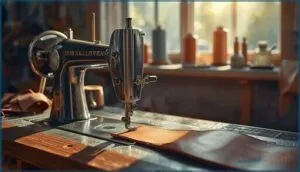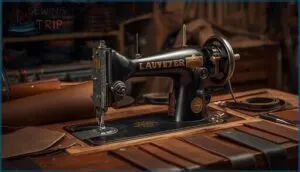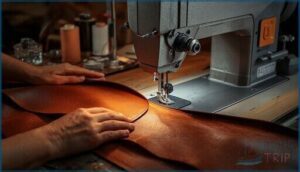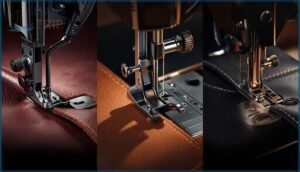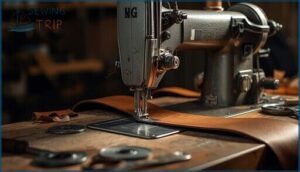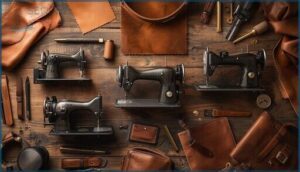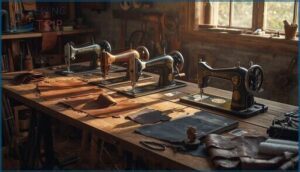This site is supported by our readers. We may earn a commission, at no cost to you, if you purchase through links.
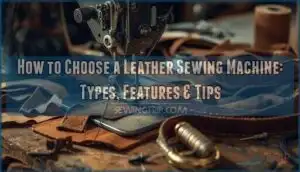
The truth is, choosing a leather sewing machine isn’t about picking the biggest motor or the fanciest digital display. It’s about matching the right tool to your craft, whether you’re shaping a curved bag, stitching a belt, or piecing together a custom sneaker.
Understanding how to choose a leather sewing machine will set you up for clean stitches, lasting durability, and real confidence in your work.
Table Of Contents
Key Takeaways
- Machine bed type—cylinder arm for curved work, flatbed for large flat pieces, or post bed for intricate seams—determines which leather projects you can tackle effectively.
- Feed mechanism choice matters more than motor size: compound feed prevents slippage on thick layers, while needle feed delivers precision on heavy multi-layer builds.
- Match your machine’s maximum sewing thickness and motor power (400–750 watts for industrial work) to your specific leather weight, from light garment leather under 6 oz. to heavy saddle leather over 10 oz.
- Specialized features like adjustable presser foot pressure, walking foot attachments, and proper needle selection transform ordinary machines into professional-grade tools for consistent, durable stitching.
Types of Leather Sewing Machines
Not all leather sewing machines are built the same, and the shape of the machine bed determines what types of projects you can tackle. Each design gives you access to different parts of your leather work, which matters when you’re sewing bags, belts, or upholstery.
Let’s look at the three main types you’ll encounter.
Cylinder Arm Machines
Cylinder arm machines give you supreme maneuverability for tackling curved seams and tight spaces. The cylinder arm design—a narrow, tube-like bed—lets you slip cylindrical pieces like bag bodies or glove fingers right over it, making three-dimensional leatherwork feel natural. With motor power ranging from 600W to over 880W and build quality that accommodates up to 7/8-inch material thickness, these workhorses deliver precision where flatbed machines can’t reach. These machines are often used in textile industries for manufacturing leather goods.
- Perfect for cylindrical items like bags, gloves, and shoe uppers
- Compound feed mechanisms prevent slippage on thick, layered leather
- Presser foot lifts up to 16mm accommodate bulky materials effortlessly
- Sturdy metal frames guarantee stability during heavy-duty stitching
Flatbed Machines
Flatbed machines offer superior stability when working with large, flat leather pieces like wallet panels, belts, or saddle blanks. That level working surface keeps your material from shifting, ensuring precise seam alignment every time. Industrial models like the Pfaff 1245 and Juki DNU-1541 accommodate heavy-duty leatherwork with compound feed mechanisms that prevent slippage, while domestic options such as the Singer Heavy Duty 4423 tackle lighter tasks when you’re just starting out. A walking foot machine ensures smooth feeding of the material.
| Feature | Industrial Flatbed | Domestic Flatbed |
|---|---|---|
| Motor Power | Up to 550W servo motors | 60–90W standard motors |
| Leather Thickness | Handles 10+ oz. multi-layer leather | Light leather up to 6 oz. |
| Automation Features | Programmable stitching, digital controls | Manual speed adjustment only |
Modern flatbed types increasingly feature automation capabilities like programmable patterns and real-time monitoring, making repetitive leatherwork faster and more consistent. You’ll find brand diversity across Juki, Pfaff, Singer, and TechSew—each engineered specifically for leather applications. Regular maintenance tips include oiling feed mechanisms and using leather-specific needles to optimize performance. For flat seams and standardized leather goods production, the advantages of flatbed machines become crystal clear compared to cylinder or post bed alternatives.
Post Bed Machines
When your leatherwork demands stitching intricacies or curved seams—think bag gussets or shoe uppers—postbed machines step in where flatbeds fall short. That vertical column lets you maneuver bulky projects with ease, especially in industrial applications.
Automation features and variable presser foot control are now standard, reflecting market trends. If your focus is on complex leather sewing, postbed machines offer unparalleled flexibility among types of leather sewing machines.
Feed Mechanism Options
How your machine feeds leather plays a big role in stitch quality and ease of use. Each feed mechanism treats the material differently, so it’s important to know what sets them apart.
Here’s a quick look at the main options you’ll find.
Compound Feed / Compound Walking Foot
Ever wrestled with material slippage on thick leather? The compound walking foot feed system is your answer. It delivers uniform stitching, even through multiple layers, thanks to its synchronized needle and feed mechanism. Ideal for industrial applications and heavy-duty projects, this system boasts extended maintenance intervals and market dominance.
- Precise seam control
- Reliable stitch consistency
- Reduced manual adjustments
Drop Feed / Regular Feed
Curious how regular sewing machines handle leather? Drop feed mechanisms use feed dogs beneath the fabric, but with thicker material, you’ll notice more fabric slippage and less stitch consistency. Adjusting the presser foot and tension helps, yet limited versatility remains.
Most domestic machines struggle beyond 2–3 mm thickness—industrial models offer improved features, but feed mechanism choice is critical.
Needle Feed
Stepping up from drop feed, needle feed machines bring a leap in stitch consistency and material control. With each stitch, the feed mechanism moves leather layers together, reducing slippage and misalignment. If you’re tackling thicker hides or multi-layer builds, consider needle feed for:
- Consistent stitch length
- Reliable performance on heavy materials
- Manageable maintenance costs and strong market adoption
Essential Features for Leather Sewing
When you’re choosing a leather sewing machine, certain features make all the difference in your results. You’ll want to look for qualities that match the demands of thick, tough materials.
Here are the essentials to keep in mind as you compare your options.
Maximum Sewing Thickness
How thick is too thick? Your machine’s maximum sewing thickness is where material density, motor torque, and foot clearance all collide. For example, flatbed models handle up to 13 mm, while cylinder arm machines tackle 22 mm of heavy fabric. Stitch quality drops past these limits—choose wisely.
| Machine Type | Max Thickness (mm) |
|---|---|
| Flatbed Industrial | 10–13 |
| Cylinder Arm Heavy | 16–22 |
| Walking Foot Light | 8–11 |
| Entry-Level Home | Trying to sew thick leather with a weak motor feels like fighting an uphill battle with every stitch |
For leatherwork, motor wattage and type matter. A servo motor beats a clutch motor for energy efficiency and torque control, letting you sew slow or fast.
Heavy-duty motors (400–750 watts) handle dense hides, while direct-drive models reduce motor maintenance and noise.
Special Features and Attachments
Imagine tailoring leather with the precision of a master craftsman—your machine’s special features make all the difference. Adjustable presser foot pressure lets you switch between delicate and rugged hides, while speed reducers offer slow-stitch control for perfect seams.
Interchangeable presser foot types, adaptable needle systems, and edge attachments expand your creative range.
Quality builds and practical leather sewing machine accessories turn ordinary projects into professional work.
Machine Recommendations by Application
Choosing the right leather sewing machine depends on what you plan to make. Different projects call for different features and strengths.
Here’s how you can match your machine to your craft.
Bags, Wallets, and Upholstery
How do you guarantee every stitch in your leather goods holds up over time? For bags, wallets, and upholstery, a heavy-duty leather sewing machine with a walking foot is essential. Prioritize:
- Stitch Durability for daily use
- Edge Finishing on visible seams
- Design Complexity for intricate shapes
- Material Combinations—nylon, canvas, leather
- Project Scale—small wallets to large upholstery
Leather Garments and Belts
If you’re sewing leather garments or belts, your machine’s specs matter as much as your craftsmanship. For Garment Leather Types and Belt Thickness Capacity, look for a cylinder arm or a sturdy flatbed with adjustable pressure feet.
Stitch Accuracy Needs call for needle feed or compound feed systems. Motor Torque Matters—aim for at least 550 watts.
With the right leather sewing machine features, you’ll handle Garment Weight Leather with precision.
Heavy Duty Items Like Saddle Bags
When you step up from belts to saddle bags, leather thickness and motor power become your main concerns. Industrial sewing machines with a walking foot and compound feed deliver stitch consistency on saddle skirting up to 12 oz.
Automation options like digital tension and thread trimming boost efficiency, while sturdy builds extend machine lifespan. Adjustable stitch length keeps your heavy-duty projects looking sharp.
Custom Shoes and Sneakers
As you move from saddle bags to custom shoes and sneakers, precision and adaptability become the heart of your process. Choosing a leather sewing machine for these leather projects means weighing features that support creative freedom and technical accuracy. For custom footwear, look for:
- Narrow post-bed for tricky curves
- AR fitting support
- AI design compatibility
- Modular design options
- Sustainability practices with plant-based leathers
Narrowing Down Your Choice
Choosing the right leather sewing machine means weighing a few key factors. Your needs, materials, and project goals all play a part.
Let’s look at what you should consider before making your decision.
Assessing Leather Type and Thickness
Ever tried pushing a regular needle through full-grain leather? It’s like threading a brick. Leather grades and thickness units matter—1 mm is about 2.5 oz, and heavy weight leather calls for serious machine matching.
For thick fabrics, proper needle selection is essential. If you want consistent seam quality, always match your machine’s capacity to your material thickness.
Selecting The Right Feed Mechanism
How do you know which feed mechanism suits your project? When material thickness climbs past 5 mm, a walking foot or compound feed keeps stitch accuracy high and prevents slipping. Needle feed shines for precise curves and detailed work. Feed dogs alone often falter with heavy leather. Think about production speed and your own skill level before choosing.
- Feed mechanism types
- Material thickness compatibility
- Stitch accuracy needs
- Production speed demands
- User skill considerations
Evaluating Motor Power and Special Features
How do you balance muscle with finesse when choosing a machine? Look for servo motor watts matched to your torque requirements—750 watts or more for thick hides. Speed control and needle positioning let you work slow and precise.
Energy efficiency matters for long sessions. Prioritize sewing machine features like adjustable presser foot pressure and varied stitch options to fit your craft.
Comparing Machines for Specific Applications
Choosing the right leather sewing machine isn’t just about specs—it’s about matching machine type to product application.
For bags, prioritize wide workspaces and bag machine features. Garments benefit from specialized garment feed types. Saddlebag power needs call for industrial machines with powerful motors. Shoe sewing precision demands programmable controls.
Compare application factors and leather sewing machine specifications to make certain your investment fits your craft.
Frequently Asked Questions (FAQs)
How do I maintain a leather sewing machine?
It’s no coincidence that regular cleaning frequency, oiling schedule, and needle maintenance keep your leather sewing machine running smoothly.
Tension adjustments and preventative measures, like dusting and proper lubrication, help avoid common mistakes in leather sewing and machine upkeep.
Can I upgrade parts of my leather sewing machine?
Absolutely, you can upgrade parts of your leather sewing machine to boost motor power, improve stitch length, or swap in durable metal accessories.
Aftermarket availability is strong, but always check part compatibility—especially for needle upgrades and motor upgrades during machine maintenance.
What is the average lifespan of a leather sewing machine?
Like a well-oiled machine that stands the test of time, a leather sewing machine generally lasts 20–30 years with proper machine maintenance and upkeep.
Durable materials, motor longevity, and usage intensity all shape its lifespan, especially in industrial-grade models.
How does humidity affect leather sewing machines?
Humidity quietly works against your leather sewing machine, causing corrosion, lubricant degradation, thread brittleness, mold growth, and material warping.
Invest in machine maintenance and upkeep, use a dehumidifier, and store your industrial sewing machine carefully for corrosion prevention.
Are there eco-friendly leather sewing machines available?
Waste not, want not” rings true here. Yes, eco-friendly leather sewing machines exist. Look for models with recycled metal components, energy-efficient motors, and manufacturers offering take-back programs for e-waste reduction—budget home sewing machines increasingly feature sustainable manufacturing practices.
How often should a leather sewing machine be serviced?
Service your leather sewing machine every 3-6 months with moderate usage frequency. Heavy industrial sewing machine use with thick leather demands monthly maintenance, while light operational hours allow 12-18 month intervals.
Watch for servicing signs like noise or stitch issues.
What maintenance steps prevent leather residue buildup?
Clean feed dogs and needle plates after each project, oil your machine every three to six months, replace needles regularly, use quality bonded nylon thread, and keep your workspace dust-free.
Which accessories improve leather sewing efficiency?
Think of accessories as your machine’s support crew—each one sharpening your edge. Walking foot, Teflon presser foot types, servo motor with speed reducer pulley, specialized needles, adjustable presser foot pressure, guiding workholding tools, and lighting magnification boost precision and speed considerably.
Are there eco-friendly options for leather sewing machines?
Yes, modern industrial-grade leather sewing machines now feature energy conservation through servo motors, recycled components, and eco-friendly materials.
Some hand-crank and manual operation models offer sustainability benefits by eliminating electricity use entirely.
How does warranty coverage differ between brands?
Warranty coverage varies widely—machine heads often carry 25-year or lifetime protection, while motors and electronics generally receive one to two years.
Industrial brands usually offer more extensive coverage than domestic machines, reflecting their professional-grade construction and service expectations.
Conclusion
Think of your machine choice like picking the right horse for the trail ahead—speed matters less than endurance and fit.
How to choose a leather sewing machine comes down to matching feed type, thickness capacity, and arm style to the work you’ll actually do. Get those three right, and your stitches will hold through years of wear. The rest is just noise.
Choose deliberately, stitch confidently.
- https://www.fortunebusinessinsights.com/industry-reports/industrial-sewing-machines-market-100613
- https://www.accio.com/t-v2/business/trend-of-post-bed-leather-sewing-machine
- https://www.prnewswire.com/news-releases/global-sewing-machines-strategic-business-report-2024-2030---specialized-sewing-machines-for-sewing-repairing-and-fixing-leather-products-grow-in-prominence-302067297.html
- https://www.persistencemarketresearch.com/market-research/industrial-sewing-machines-market.asp
- https://www.sailrite.com/What-to-Look-for-in-Leather-Sewing-Machine

